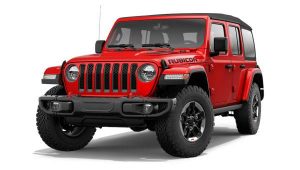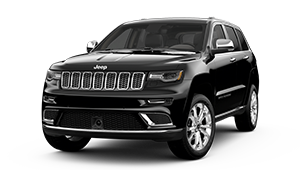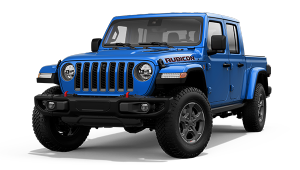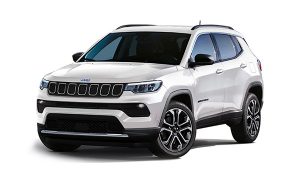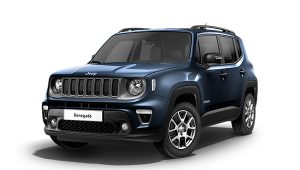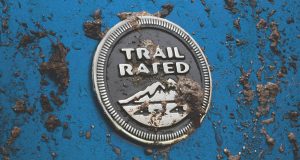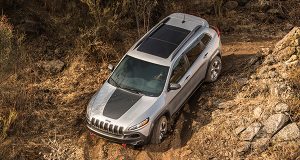
TALK THE TALK
,Jeep® Brand vehicles are designed and built for the off-road world. Here are some of the most frequently asked questions and a glossary to help get you familiar with life on the trail.
,
FREQUENTLY ASKED QUESTIONS
DRIVING A 4X4
A Full-Time 4x4 system operates by default in four-wheel drive and can travel safely and securely on all surfaces. The system uses either a clutch or a center differential to allow the front and rear driveshafts to turn at varying speeds. Whether the road is covered in snow or is dry as dirt, this system can be utilized confidently.
All-Wheel Drive (AWD) is almost the same as full-time Four-Wheel Drive (4WD). It is also a system that powers all four wheels of a vehicle at all times. It can be used full-time on all surfaces, including pavement, like full-time 4WD. The only difference is that a ''4-low'' setting is not available on AWD vehicles. Due to the lack of ''low range'', AWD vehicles are much less capable in off-road settings than full-time 4WD vehicles, but work perfectly well on-road.
Part-Time 4WD operates by default as a two-wheel drive vehicle. Unlike the full-time system, part-time 4WD doesn’t use a center differential. The system instead locks the front and rear driveshafts, making it better for use exclusively during off-road travel or challenging road conditions. When on dry pavement or under normal driving conditions, the driver should switch to the vehicle’s two-wheel-drive mode. If drivers use Part-Time 4WD excessively, they may experience driveline noise or binding that can lead to overheating or early part failure.
On-Demand 4WD systems operate primarily in two-wheel drive during normal driving conditions. When a slippery surface such as snow or mud is encountered, 4WD is automatically engaged and power is transferred to the secondary axle.
Part-time 4x4 systems lock the front and rear axles together so the front and rear wheels turn at the same speed. If attempting to turn or drive on dry surfaces, binding (''crow hop'') and driveline noise (a ''bang'' or ''shudder'') will occur, which can lead to overheating and early part failure.
Crow hop happens when using the 4x4 part-time system on dry pavement or during turns. 4x4 part-time systems don’t use a center differential, so the front and rear wheel axles are locked together. If attempting to maneuver or turn on dry pavement, the tires will lose traction, causing driveline noise, such as a ''bang'' or vehicle ''shudder''.
QUADRA-LIFT® AND SELEC-TERRAIN® SYSTEMS
The different settings offered from Selec-Terrain® are designed for specific terrains or conditions. Each setting will optimize the vehicle’s systems for that terrain. Switching between settings is easy using the rotary knob. A variety of settings deliver ultimate driving stability by coordinating vehicle systems, including throttle control, transmission shifting, transfer case, traction control and Electronic Stability Control.
Leaving the vehicle in AUTO mode will allow it to automatically select the correct drive system for the condition it senses.
Both systems can be used when parked or moving. The Quadra-Lift® Air Suspension System raises the vehicle to allow more clearance for driving through rocky terrain. If the vehicle is moving, you can manually select the height for the Quadra-Lift® system or have the vehicle automatically select the optimal setting.
With the Quadra-Lift® Air Suspension System, there are speed thresholds for various height settings. When traveling on the highway, the Quadra-Lift® system will automatically lower the vehicle to be more aerodynamic for better efficiency and handling. The vehicle can be raised to give more clearance when navigating off-road trails and can be set to automatically lower when it is parked to allow for easier entry and exit.
HIGH RANGE/LOW RANGE
Low-Range is for extreme off-road situations needing more torque with low speed, such as getting out of a tough driving spot or steep climbs. More torque does not mean more traction though, so it can be unsafe on slippery surfaces like snow, ice or mud.
Do not exceed 25 mph (40 km/h). When engaging or disengaging low-range mode, do it only when the vehicle is moving at 2 to 3 mph (3 to 5 km/h) or slower. Avoid using this mode for normal driving.
No. You can shift into 4x4 Low-Range when the vehicle is rolling at 2 to 3 mph (3 to 5 km/h) by shifting an automatic transmission into Neutral or depressing the clutch pedal on a manual transmission.
Yes, but this is not recommended. The teeth of the gears may not be properly aligned so difficulty may occur. The preferred method is to shift into the range when going 2 to 3 mph (3 to 5 km/h) in Neutral. After shifting, return the transmission to the desired gear.
High-Range mode can be used if you need more traction over surfaces like snow, ice or rocky roads and need to go faster than low-range mode (25 mph or 40 km/h).
High-Range is designed for off-road conditions (i.e. gravel, mud, sand). You should not go faster than road conditions permit.
The shift can be done while stopped or in motion. If the vehicle is moving, shifts can be made up to 55 mph (88 km/h).
OFF-ROAD GUIDE
Always check your vehicle before going off-road. Make sure your battery is fastened, all hoses are in good condition and oil and fluids are topped off, including fuel. Be sure that all four tires are in good condition and have the proper tire pressure. Avoid travelling alone, especially into unfamiliar territory.
Once off-road, put your vehicle in 4WD whenever you anticipate a need for additional traction. It's difficult to engage 4WD after you get stuck. You'll also want to get into the habit of looking over your hood, scanning left to right so you can clearly see what you're approaching on the trail. If you're just watching the left tire, there's a good chance you'll get the right tire in trouble. Avoid putting your head outside the vehicle to see what's coming. Many trail masters recommend keeping your thumbs up and out of the way of the steering wheel spokes in rough terrain. If your tire suddenly falls off a rock, your steering wheel could quickly rotate and injure your thumb. Generally, vehicles with power steering, like all Jeep® vehicles, lessen the chance of sudden steering wheel rotation.
Speed and power are not required in rough off-road driving. In low-range 4WD, the low gearing and low speed of Jeep® 4x4 vehicles at idle will generally pull you over obstacles. In many cases, with manual transmissions, letting the clutch out slowly and allowing the vehicle to crawl over obstacles in the lowest gear is the best scenario. As a matter of fact, on the Rubicon Trail, the average speed is a mere 1-5 miles per hour.
Generally, when snow or mud is present on the driving surface, it is the right time to engage your on-demand or part-time 4WD system. If you have an all-time system like Quadra-Trac I®, there is no input required from you. In heavy snow, when pulling a load, or for additional control at slower speeds, shift the transmission to a low gear and shift the transfer case to 4WD-LOW if necessary (Quadra-Trac I and Quadra-Trac® SRT® do not offer a low range). Don't shift to a lower gear than necessary to maintain momentum. Over-revving the engine can spin the wheels and traction will be lost. If you begin to lose traction in snow or mud, turn your steering wheel back and forth rapidly. This will generally help the wheels bite into fresh terrain and pull you through. If traction is lost, STOP. Wheel spinning will just dig you in deeper. The key is to maintain forward momentum.
For better traction in sand, drop air pressure 10-12 pounds below normal pressure on conventional tires. (Return to normal pressure after use in these conditions.) Try high-range 4WD to maintain forward momentum. Depending on the condition of the sand, low-range 4WD and alternative gear selections may be necessary. Also try to make wider turns if at all possible. Tight turning slows the vehicle abruptly and can get you stuck. Again, maintaining forward momentum is key.
When climbing or descending hills ALWAYS go straight up or down. It's also smart to know what's on the other side before going up. At the base of the hill you should apply more power. Ease up on the power as you approach the top and before going over the crest. If you stall on the ascent, back straight down the hill in reverse. For downhill travel, always use the lowest gear with a manual transmission. When descending a hill in low-range, do not disengage the clutch and allow the vehicle to coast. Severe damage to your clutch disc may result. Allow the gears and engine compression to slow you down, using the brakes only to fine-tune your speed. If equipped with an automatic transmission, use low-range and the lowest drive setting. NOTE: NEVER drive up a hill at an angle. If the hill is very steep and you don't feel confident that you or your vehicle can make it up, don't attempt it. Never get sideways on a steep slope as this can lead to vehicle instability. Off-roading can be very challenging. Remember, go as slow as possible. Use common sense with safety being the foremost concern.
We call it "crawling" for a reason. Use a low gear and low-range 4WD and just let the vehicle crawl and idle (with as little throttle as needed) when going over obstacles like rocks or logs. Never straddle rocks. A vehicle with 10 inches of ground clearance will not go over a 12-inch rock! Maneuver the tire on top of the rocks and crawl over them slowly. If you hear scraping, don't panic. Your Jeep® 4x4 vehicle's skid plates and rock rails (this equipment varies depending on what Jeep 4x4 vehicle and packages have been purchased or leased) will take the brunt of the beating. Dropping tire pressure 3-5 pounds improves traction and helps avoid tire punctures. (Return to normal pressure after use in these conditions.) Remember, the ideal speed for rock crawling is 1-3 miles per hour.
Always leave the trail in better shape than you found it. Observe posted signs and stay on trails and recreation areas approved for off-roading. Use your good judgment in protecting the beauty and solitude of the area. Don't leave anything behind and, better yet, pick up and remove any trash that others have discarded. And if the terrain looks especially fragile, take an alternate route. For more information on how to Tread Lightly, visit treadlightly.org.
GLOSSARY
A - B
A measure of how steep a hill or slope can be for the vehicle to begin its climb without scraping or hitting the front undercarriage. Useful when needing to know a vehicle’s ability to navigate through severe off-road terrain with boulders and logs.
The ability to keep as many tires as possible on the ground when traveling over rough terrain, allowing for a more efficient transfer of power.
A metal rod that connects the front wheels or the rear wheels to each other. It is generally static and built to balance or transfer bending movements.
Designed to prevent loss of traction by transferring torque from one wheel to another when slippery conditions are detected. Uses the antilock brake system to apply braking to wheels that have lost traction.
C - D
Distributes torque to the front and rear driveshafts on full-time 4x4 vehicles. It allows the front and rear wheels to rotate at different speeds during cornering.
Flexible metal helix-shaped coils that can be compressed and stretched and return to their original form when resting. Coil springs support the weight of the vehicle as the wheels travel up and down over bumpy surfaces.
Determines the ability of the vehicle to safely and securely "creep" along at very low speeds in Low-Range and lowest gear when going up very steep hills or on descents. The higher the crawl ratio, the better the off-road capabilities.
Usually caused when basic 4x4 or part-time 4x4 mode is used on dry pavement. Signs of crow hop are a "bang" noise, vehicle "shudder" and tire scuffing.
A measure of how steep the slope of a hill can be for the vehicle to descend to level ground without scraping or hitting the rear undercarriage.
E - H
Effectively handles the extra output from the transfer case and helps to ensure smooth and durable driveline operation.
Disengages the front axle from the front driveline when shifting from four-wheel drive to two-wheel drive. Helps reduce unnecessary front driveline wear, noise and fuel consumption.
Determines the ability of the vehicle to navigate over uneven ground without damaging the undercarriage.
J - N
Jounce is when the suspension attached to the tires compresses when going over a bumpy surface. If a wheel is at "full jounce”" the wheels are compressed to their limits. Rebound is the opposite, when the coil spring expands (as occurs when driving on a regular surface).
Works the same as an axle differential with an added advantage. When the drive wheel begins spinning on slippery surfaces, a limited-slip differential automatically transfers torque to the opposite wheel to help improve traction.
Provides consistent traction by "locking" the axle shafts together so that torque distributes the same speed between wheels for rough and/or wet terrain. Do not use on dry, paved roads.
Low-range is a 4x4 mode for extreme situations needing more torque at low speed, such as getting out of a tough driving spot or navigating slippery surfaces, steep climbs, dense mud, soft sand or water.
Describes the vehicle’s ability to navigate through tight corners, around obstacles and into and out of tight spots.
O - S
Transmits 50% of the torque to both wheels on the same axle. If you are running an open differential and you hit a loose patch, the differential will send power to the wheel that is encountering the least resistance. This results in wheel spin on the loose patch side, while the solid contact side barely moves.
The RTI is a measure of articulation. It tests how well a vehicle can keep all wheels on the ground while off-roading and traveling over bumpy obstacles. The better the flexibility, the better the traction and stability of the vehicle.
A solid axle connects the suspension of two wheels while coil springs support the vehicle’s weight to allow the wheels to travel up and down over terrain.
T - Z
Heavy-duty steel hooks that provide attachment points for recovery straps and winch cables should you get stuck.
Trail Rated® traction is like grip on asphalt that helps you stay in control on untamed terrain, slippery (wet, mud, snow) conditions and on steep grades.
Transfers power from the transmission to the front and rear driveshafts for high and low range modes.
Transfers torque into driving power through gear sets. The gear sets multiply engine torque to meet specific driving demands.

